
August 1
| 1945 | AASHO concurs in the initial "Design Standards for the National System of Interstate Highways," designed to "set the values or controls, the use of which is intended to produce highway facilities that represent the best practice in the light of present knowledge." The standards accommodate the 30th highest hourly traffic density and, in most but not all cases, require access control, separation at rail crossings, and elimination of cross traffic at grade. The standards were developed by AASHO Special Committee on Planning and Design Policies during a June meeting in Washington, DC. |
| 1956 | With Commissioner Charles Curtiss looking on, Secretary of Commerce Sinclair Weeks signs the apportionment document for $2.55 billion in FY 1958 funds authorized by the 1956 Federal-Aid Highway Act, the largest amount ever provided for roads to date. The first apportionment under the 1956 Act, totalling $1.125 billion, took place the day it was signed, June 29, 1956. |
| 1965 | In an interview with The New York Times, Robert O. Swain, president of the International Road Federation, says that his organization has joined with BPR in a $150,000 project to send 17 road experts to Europe, the Far East, and South America. "Despite great advances here, United States road builders are a long way from knowing everything there is to know about their art," commented Swain. |
| 2007 | The I-35W bridge in Minneapolis, MN, collapses into the Mississippi River during the evening peak period. Thirteen people die and hundreds are injured. At the request of President George W. Bush, Secretary of Transportation Mary E. Peters is on the scene within hours of the collapse. She taps Administrator J. Richard Capka to manage a team of experts assigned to replace the bridge. (See September 18, 2008) |
August 2
| 1947 | Commissioner Thomas MacDonald and the Federal Works Administrator, Major General Philip B. Fleming, announce the general locations of the first designated routes of the National System of Interstate Highways (as it is called). The routes total 37,681 miles, including 2,882 miles of urban thoroughfares. The remaining mileage of the 40,000-mile Interstate System, as authorized by the Federal-Aid Highway Act of 1944, was reserved for auxiliary urban routes.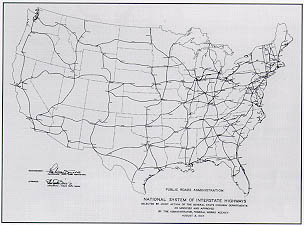
|
| 1956 | The Missouri State Highway Commission awards a construction contract for 13.3 miles of U.S. 66 (I-44) in Laclede County. BPR District Engineer S. W. O'Brien telephones Headquarters to confirm that it is the first Interstate contract awarded under the 1956 Federal-Aid Highway Act. The State also awards a contract for a project to pave a 2.6-mile section of U.S. 40 (I-70) in St. Charles County (west from the Missouri River), which will be the first on which actual construction is started under the Act. The State posts a sign at the site to that effect. (See September 26, 1956.)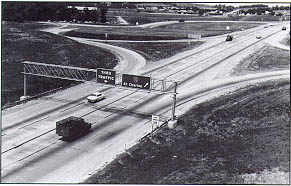
(Photo courtesy of the Missouri Highway and Transportation Department) |
| 1990 | Iraq invades Kuwait, taking foreign hostages, including three FHWA employees--Monte Darden, Hristaki Sofokidis, and John Turley. They were on their last day in the country closing out a 22-year technical assistance program. On December 2, shortly after their release, they arrive in Germany. |
August 3
| 1972 | The USDOT transmits the 1972 National Transportation Report to Congress, the first in a planned series of periodic reports on the state of the Nation's transportation system and the planning alternatives of Federal, State, and local governments for improving the system over the longer range future. |
| 1973 | Administrator Norbert Tiemann announces a policy, known as "Last Resort Housing," that will allow States to use Federal-aid funds to provide special housing for people whose homes are displaced by Federal-aid projects and for whom comparable replacement sale or rental housing is not available. The new policy, he says, "purposely provides for broad latitude and creative thinking by the State highway agencies." |
| 1978 | After serving since June 1977 as Deputy Administrator, Karl S. Bowers is appointed Administrator (and is sworn in by Secretary of Transportation Brock Adams on August 31). Bowers had been appointed Acting Administrator on May 1 following the resignation of Administrator William Cox. In a May 1 notice to all employees, Bowers had said, "Highways are as important and vital today as they always have been . . . . The only difference is that today they are no longer a separate entity in the transportation field. We think of highways today as an integral part of the total transportation system, one which forms a connecting link with other transportation modes."
"As we move toward the close of the 20th Century, our projections must not be limited, and our thinking must be in terms of total transportation responsibility." |
August 4
| 1892 | House Speaker Charles Crisp of Georgia refuses to allow a vote on General Roy Stone's National Highway Commission Bill, effectively killing it when Congress adjourns the next day. Some House members had objected to the bill as an invasion of States' rights and also feared it would lead to a large-scale road building program. Disappointed, General Stone, co-lobbyist James Dunn, and others turn their attention to the problem of winning public support for the bill, leading to creation of the National League for Good Roads, on October 20, 1892, to finance and direct a nationwide publicity campaign. |
| 1970 | In Atlanta, the Bridge Division holds the first of nine 3-day Bridge Inspector Training Symposia. Over 50 State and Federal bridge design, maintenance, and training officials attend. In addition to a slate of speakers, headed by AASHO Executive Director Alfred Johnson, the symposium features a chapter-by-chapter presentation of the Bridge Inspector's Training Manual by the Bridge Division's Stanley Gordon, John O'Fallon, and Joseph Policelli. |
August 5
| 1933 | The first highway project under the National Industrial Recovery Act (June 16, 1933) gets underway on the Salt Lake City to Saltair Road in Utah. By October 27, 1934, 16,330 miles of new roadway projects had been completed, 7,880 additional miles were under construction, and 2,845 miles more were definitely scheduled for construction (a total of 27,055 miles). |
| 1968 | Edward J. DePina is appointed Division Engineer for FHWA's Connecticut Division Office. DePina, who joined FHWA in 1965 after a career that included service as a Captain in the U.S. Army Corps of Engineers and a stint with the Massachusetts Department of Public Works, is the first African-American to serve as an FHWA Division Engineer. |
| 1971 | In Named Individual Members of the San Antonio Conservation Society, et al. v. The Texas Highway Department, the U.S. Court of Appeals, Fifth Circuit, resolves whether a State, having accepted Federal-aid funds for a project (for construction of the North Expressway through Brackenridge Park in San Antonio), can then build the road with State funds to avoid Federal requirements. The court says no. "The state, by entering into this venture, voluntarily submitted itself to federal law. It entered with its eyes open," the court finds. Section 154 of the 1973 Federal-Aid Highway Act provides relief for Texas by declaring an end to the contractual relationship between the Federal and State governments with respect to the North Expressway. |
August 6
| 1905 | General Roy Stone dies at Phoenix House, Mendham, New Jersey, after a brief illness, survived by his wife Mary and daughter, Margaret (Lady Monson of England). He is buried August 10 with full military honors in Arlington National Cemetery. Stone was a hero of the Civil War, particularly distinguishing himself during a heroic stand at McPherson's Ridge on the first day of the Battle of Gettysburg. He also served as a volunteer in the Spanish-American War during a leave of absence from ORI in 1898.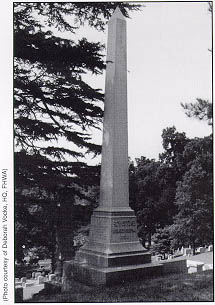
"General Stone died at the Phoenix House, Mendham, N.J., August 6, after a short illness. Such is the brief statement of the transition from life to life of a man of exceptional vigor of mind and strength of character." |
| 1993 | Following a series of fatal truck accidents on the Capital Beltway, Administrator Rodney Slater convenes a meeting with over 125 Federal, State, and local officials to discuss ways of improving beltway safety. Recommendations, including stepped-up truck inspections and the use of photo radar to detect speeders, are released on December 20, 1993. The Washington Post comments editorially on December 25 that, "Mr. Slater and the participating state and local officials have delivered a solid response to Beltway dangers--and the interest should not be allowed to wane." (A similar conference, convened by Executive Director R. D. Morgan, on September 9, 1988, had resulted in numerous initiatives to improve beltway operation and safety.) |
August 7
| 1937 | In accordance with the road user tax anti-diversion requirement of Section 12 of the Hayden-Cartwright Act (See June 18, 1934), BPR reduces New Jersey's Federal-aid funds by $250,000 for FY 1937. The Act stated that decreased funding was justified because ". . . it is unfair and unjust to tax motor vehicle transportation unless the proceeds of such taxation are applied to the construction, improvement or maintenance of highways." The only other State to lose funds is Massachusetts, with BPR action taken on June 2, 1938 ($472,862 in FY 1938 funds), but the provision, along with an improving economy, brought diversion under control. |
August 8
| 1916 | All applications, accompanied by a medical certificate, must be in today for "United States Civil Service Examination, Senior Highway Engineer (Male)," paying $2,200-$4,000 a year. Candidates will be rated on the basis of education and preliminary training (20 percent), responsible experience in engineering and fitness (30), and responsible experience in highway engineering (50). Minimum age is 30. |
| 1973 | Secretary of Transportation Claude Brinegar administers the oath of office to Lester P. Lamm, who succeeds Martin F. "Pat" Maloney as Executive Director. Lamm, a native of Hull, MA, began his career with BPR in 1955. On September 17, 1982, he would become Deputy Administrator, the first to rise from career ranks within FHWA. "We, as a family, can truly look back with pride at our accomplishments. We should also look ahead with confidence at the challenges we now have, because together we can do anything. But only as a family," said Lamm. |
| 1980 | Secretary of Transportation Neil Goldschmidt administers the oath of office to Ms. Alinda C. Burke, the first woman to become Deputy Federal Highway Administrator. A native of Flint, MI, Ms. Burke grew up in Fremont, CA, receiving her Bachelor's Degree in political science from Stanford University in 1968. After receiving a Master's Degree from the University of Washington's Graduate School of Public Affairs, she held several government positions in Seattle, before joining Public Technology, Inc., a nonprofit urban research firm in Washington, DC (1975-1979). She served as a Special Assistant to Secretary Goldschmidt before her appointment as Deputy Administrator. "I'm proud to have been chosen for this position but . . . I am extremely respectful of those of you who have made a life's work of giving this nation the finest highway system in the world."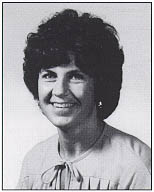
Deputy Federal Highway Administrator |
August 9
| 1954 | Commissioner F. V. du Pont issues the first "Cherry Memorandum." It indicates that to ensure uniform interpretations nationwide, whenever a ruling or interpretation of general importance is made in Washington, DC, copies will be sent to all field offices on cherry-colored paper. "I trust," du Pont says, "that every effort will be made in the Divisions to see that they use Bureau policies, as distinguished from Division policies." Cherry Memorandum No. 2 (August 16) concerns Section 17 of the Federal-Aid Highway Act of 1954, which requires that projects "shall be performed by contract awarded by competitive bidding . . . unless the Secretary of Commerce shall affirmatively find that, under the circumstances relating to a given project, some other method is in the public interest." |
August 10
| 1956 | PPM 20-8 implements Section 116(c) of the Federal-Aid Highway Act of 1956, which requires that in deciding whether to bypass any city, town, or village, the State highway department must hold public hearings or afford the opportunity for such hearings, and consider the economic effects of the action. |
| 1970 | After the National Highway Safety Bureau was separated from FHWA to become the seventh USDOT operating administration in March 1970, FHWA was reorganized, effective this date. Under the change, BPR is eliminated as an identifiable separate organizational component. Instead of a bureau structure, FHWA is divided into six components, each headed by an Associate Administrator (Administration, Planning, Engineering and Traffic Operations, Motor Carrier and Highway Safety, Research and Development, and Right-of-Way and Environment). The Offices of Chief Counsel, Civil Rights, Program Review and Investigations, and Public Affairs, each headed by a Director, report directly to the Administrator. |
| 1989 | Attorney General Dick Thornburgh administers the oath of office to Dr. Thomas D. Larson as the 12th Federal Highway Administrator. He calls the post-Interstate period "a hinge point in this country's transportation history."
"Under Secretary Skinner's empowering leadership, this team will give our country the direction it needs in transportation to grow confidently, prosperously and securely towards the 21st century." |
| 1990 | Opening of the Papago Freeway in Phoenix, AZ, completes the 2,460-mile I-10, the second transcontinental Interstate route to be completed (Jacksonville, FL, to Santa Monica, CA). The Director of the Office of Engineering in Headquarters, Thomas O. Willett, who was Division Administrator in Arizona while controversy surrounding the route was resolved, is quoted as saying, "Completion of the Papago Freeway is far more than construction of concrete and steel. It represents a successful culmination of a state, city, and federal partnership forged by the challenge of a concerned public."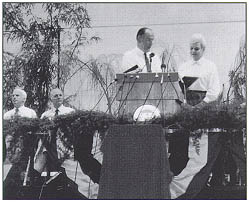
|
| 2005 | In a ceremony in the Caterpillar-Aurora Facility in Peoria, Illinois, President George W. Bush signs the Safe, Accountable, Flexible, Efficient Transportation Equity Act: A Legacy for Users (SAFETEA-LU). The Act reauthorizes Federal-aid highway, transit, and safety programs through FY 2009. The President says, "this is more than just a highway bill; it's a safety bill." SAFETEA-LU "makes our highways and mass transit systems safer and better, and it will help more people find work. And it accomplishes [these] goals in a fiscally responsible way." |
August 11
| 1924 | At the Department of Commerce, Chief Thomas MacDonald participates in a meeting of the Committee on Public Relations of the Conference on Street and Highway Safety. Participants outline procedures for helping communities put a safety program into use to reduce highway and street accidents. While methods for reducing accidents may vary, participants agreed that positive results can be obtained only by the cooperation of officials and lay bodies. |
| 1947 | Harold Allen, Principal Materials Engineer, and F. H. Jackson, Principal Engineer of Tests, complete a 28-day PRA tour of Germany, during which they inspected concrete pavements on the Autobahn. The study tour resulted from comments by returning visitors, one of whom said, "In all my experience I have never seen concrete highways in better shape after at least 7 years' service." The team finds the concrete in better shape than comparable roads in the United States, partly because of lighter loads and comparatively mild weather. |
August 12
| 1971 | FHWA releases the initial list of obsolete bridges to be replaced under the Special Bridge Replacement Program created by the Federal-Aid Highway Act of 1970. The program provides a total of $250 million to pay the 75-percent Federal share to replace bridges on the Federal-aid systems. (See "Also in May" 1971.) |
| 1984 | The Summer Olympiad in Los Angeles ends, with widespread predictions of gridlock proven false. FHWA cooperated with the California DOT and other State and local officials as they developed and implemented an integrated plan of traffic management. The Olympic bus system was used extensively, with total ridership of 1,145,350. In fact, the only major congestion of the Olympics occurred on August 8 at the Rose Bowl when bus patronage was unusually low. |
August 13
| 1962 | Maine Division Engineer R. D. Hunter, District Engineer W. P. Mitton, and Bridge Engineer R. W. Hove represent BPR at the ribbon-cutting ceremony for the Franklin D. Roosevelt Bridge between Lubec, ME, and Campobello, New Brunswick. Construction was financed by the Federal Government, the State, the Dominion of Canada, and the Province of New Brunswick. The Maine State Highway Commission designed the bridge, with BPR headquarters review. |
| 1964 | President Lyndon Johnson signs the Federal-Aid Highway Act in the White House. Authorizations include $1 billion a year for the FAP and FAS systems and extensions of these systems in urban areas (FYs 1966 and 1967).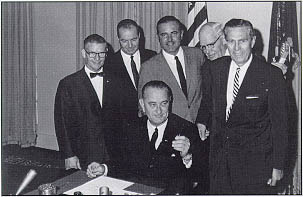
"For much too long, the man who owns and drives an automobile has been treated like a stepchild . . . . We complain about what he costs us but we never thank him for what he adds to the worth and wealth of our economy. We could not get along without him, but we often talk as though we can't live with him." |
| 1973 | The Federal-Aid Highway Act, signed today, authorizes withdrawal of Interstate segments and substitution of urban mass transportation projects (expanded to allow substitute highway projects by the Federal-Aid Highway Act of 1976). "The law," President Richard Nixon says, "will enable [localities] at last to relieve congestion and pollution problems by developing more balanced transportation systems where it is appropriate rather than locking them into further highway expenditures which can sometimes make such problems worse." An editorial in the Beacon Journal (Afron, OH, August 15) is headlined, "At Last Comes the Vital Step Toward Transportation Sanity." |
| 1993 | Administrator Rodney Slater delivers a symbolic check for $28.5 million to Governor Mel Carnahan and Chief Engineer Wayne Muri of the Missouri Highway and Transportation Department for emergency relief work as a result of the Great Flood of 1993. During the trip, Slater and Deputy Administrator Jane Garvey inspect a washed out section of I-635 in Riverside, MO, that has forced 42,000 cars to take a detour each day.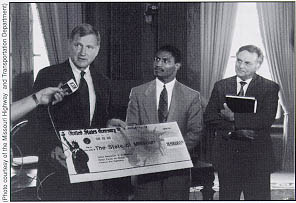
|
August 14
| 1957 | After months of consideration and viewing nearly 100 suggested shapes, sizes, and variations of Interstate route markers, AASHO's Route Numbering Committee presents its recommendations to the Executive Committee, which endorses the proposed Interstate shield and forwards the plan to the Committee on Administration. (The final version was a combination of proposals by Missouri and Texas.) The committee adopts the Interstate shield, as well as a purpose and policy statement for numbering the Interstate System (using a mirror image of the numbering plan for U.S. routes). Administrator Bertram Tallamy (a member of the Executive Committee) formally approves the plan on September 10. |
August 15
| 1908 | The American Society for Testing Materials adopts the procedure developed by Director Logan Page for testing the toughness of rock. |
| 1963 | The Right-of-Way Manpower Utilization Task Force, appointed by Administrator Rex Whitton on December 19, 1962, submits its report. Information gathering had included field interviews in all regions and 24 division offices. The report recommends that the Office of Right-of-Way and Location conduct supervisory inspections of regional office right-of-way operations. The inspections will allow headquarters staff to understand regional problems while helping regional staff to implement existing policy in a uniform way. |
August 16
| 1906 | Work begins on a project to replace the gravel driveway on the grounds of the U.S. Department of Agriculture Building with a macadam road. Because the old road was always muddy in wet weather or dusty when dry, Congress appropriated $3,500 for an object lesson road under OPR's supervision. The project, to be constructed over 72 working days (9 of which were lost because of rain and 10 because of nondelivery of stone), involves completion of a 16-foot wide, 2,630-foot roadway. In addition, a drainage system will be provided, with 8 catch-basins and suitable outlets into adjacent sewers. The total cost of the road is $3,301.25--and would have been less but the irregular delivery of stone resulted in much loss of labor. Labor and animal teams cost $1.50 and $4 per day, respectively, while the expert labor on the catch-basins was $6 per day. |
| 1916 | In the auditorium of the new National Museum (now the Smithsonian's Museum of Natural History), State highway officials meet with Director Logan Page and his staff to discuss proposed rules for the new Federal-aid highway program. (See July 11, 1916.) State officials had met the night before at the Raleigh Hotel to go over the regulations, so as OPRRE's J. E. Pennybacker, Jr., read each section, AASHO President Henry G. Shirley was prepared to read and explain any State recommendations. Secretary of Agriculture D. F. Huston addresses the group on the importance of the new Federal-State partnership. Huston remarks, "The main question that I am immediately concerned with . . . is whether we shall get a dollar's result for every dollar we expend for roads. I am quite sure that if we do so . . . [the people] will be willing to put much more money into good roads where they are needed." |
| 1967 | The Office of Motor Carrier Safety is reconstituted as the BMCS. |
| 1970 | A speech on "Ecology and Environment" before the NY State Association of Highway Engineers by BPR Director R.R. Bartelsmeyer concludes: "All highway people must recognize that despite the top-notch highway system we have in the United States, highways alone are not the answer to your total transportation needs. All modes must be improved and made more effective than they are today. Each mode must coordinate with other modes. There must be a team approach for the benefit of all . . . . There is no question that highways and motor vehicles are here to stay. So we can all well afford to assist in the overall transportation effort." |
| 1977 | In Nashville, TN, Administrator William Cox tells ARTBA's Contractors' Division that, "The trends in highway construction during the next decade will center basically on completing the Interstate Highway System, correcting serious structural and functional deficiencies of the Nation's bridges, and reconstructing and rehabilitating the Federal-Aid Primary Highway System." He adds, "I believe we can do this and still meet our goals for conserving money, materials, and at the same time save the environment and precious human lives." |
August 17
| 1906 | In accordance with a plan of cooperation entered into with the Forest Service in 1905, an OPR engineer begins a thorough investigation into the roads and trails in Yellowstone Forest Reserve. After completing the work on October 14, the engineer prepared a report containing estimates and recommendations for the road improvement and maintenance. |
| 1964 | Near the New Hampshire Avenue interchange, Maryland Governor J. Millard Tawes cuts a ribbon officially opening the Capital Beltway around Washington, DC. He calls it a "road of opportunity." Administrator Rex Whitton calls it a "huge wedding ring for the metropolitan area" while Representative Carlton R. Sickles (MD) makes the day's briefest speech: "I'm so happy, I can't express myself."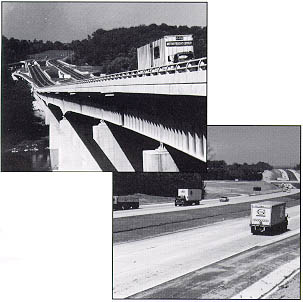
|
August 18
| 1900 | Civil and mining engineer James W. Abbott of Denver, CO, is appointed Special Agent and Road Expert to head the Western Division in the OPRI's first field structure. He joins Logan W. Page (Eastern Division and head of the road-material laboratory) and Professor J. A. Holmes of North Carolina (Southern Division, appointed August 7). Also in August, Horatio S. Earle of Michigan receives a temporary appointment to head the Middle Division and is replaced when J. H. Stout of Wisconsin is appointed to head the Middle Division in September 1900.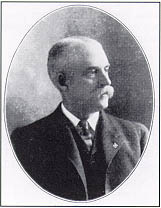
Special Agent and Road Expert Office of Public Road Inquiry |
| 2008 | Secretary of Transportation Mary E. Peters administers the oath of office to Thomas J. Madison, Jr., as the 17th Federal Highway Administrator. His most recent public service had been as Commissioner of the New York State Department of Transportation. The new Administrator would serve until the end of the Bush Administration on January 20, 2009. |
August 19
| 1942 | PRA's Senior Structural Engineer, Harry P. Hart, and Associate Highway Engineer Edward A. Willis submit a report to Commissioner Thomas MacDonald on their work as part of the U.S. Economic Mission to Bolivia authorized by the Department of State on December 4, 1941. The report includes a general study of principal routes, recommends the Cochabamba-to-Santa Cruz route as the most important for improvement, and suggests the most practicable routes for inclusion in the "National Highway System." The transmittal letter notes that, "Roads exist along the majority of these routes, but since Bolivia is a country of rugged mountain regions and deep canyons, some of these roads are very steep."![From the report prepared by Harry P. Hart and Edward A. Willis following their trip to Bolivia: TOP-"The road to Todos Santos will cross the Espiritu Santo by a 'trasbordador,'a cableway capable of carrying a truck. At the present, passengers and cargo cross in dug-out canoes and go by mule 35 Kms. to Todos Santos. Seated are engineers Gonzales, Willis, and Chiarella." BOTTOM-"On the Cochabamba-Chapare road between Sacaba and Aguirre [Bolivia] .... It is market day in the neighboring village. Walls are of dry rubble (not recommended except as 'hand-placed fill'on 1:1 slope; otherwise lime or cement mortar should be used, and the wall placed on good foundation.)"](/sites/fhwa.dot.gov/files/inline-images/0819a.jpg)
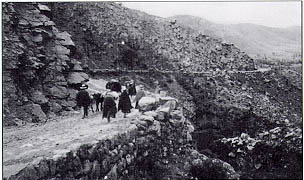
|
| 1959 | Region 9 crews working in Yellowstone National Park were all shook up, literally, by an earthquake that began at 11:37 p.m. on August 17. In inspecting the damage done by the quake, they found that the most critically affected BPR project is the reconstruction of the bridges on the Gibbon River. All new construction comes through with only minor damage, but all the roads in the western portion of the park, the hardest hit, are temporarily closed by rolling rocks and slope debris. |
August 20
| 1949 | Under President Harry Truman's Reorganization Plan No. 7, BPR is transferred from the General Services Administration (GSA) to the Department of Commerce. The Federal Property and Administrative Services Act of 1949 had abolished the Federal Works Agency, the PRA's former home. On July 1, 1949, the PRA had been renamed the BPR and shifted to the newly created GSA. BPR's 6-week stay in GSA was the Agency's shortest period as part of any Agency. |
| 1973 | Administrator Norbert Tiemann announces that the National Park Service and FHWA have reached an agreement under which all traffic control devices on roads traversing National Parks will be in substantial conformance with national standards for all other public highways. |
August 21
| 1903 | Director Martin Dodge and James W. Abbott represent OPRI at the Trans-Mississippi Commercial Congress in Seattle, WA, which concludes today. Back home, Dodge tells The Washington Star, "The revenues of the general government are so large and are raised in such a manner by indirect taxation that there would be neither hardship nor inequity if the United States should bear a considerable portion of the cost of improving some of the [Nation's] principal highways." |
| 1961 | BPR participates in the World Traffic Engineering Conference, which combines the 31st Annual Meeting of the Institute of Traffic Engineers and the International Sessions in Traffic Engineering. Participants include E. H. "Ted" Holmes ("Urban Transportation and its Future"), O. K. Normann ("Use of Electronics in Traffic Control"), Charles W. Prisk (chair, "Research into Highway Traffic Accidents" session), Donald W. Loutzenheiser (panel moderator, "Freeway Ramp Terminal Design" and panel member, "Federal Coordination of Highway and General Planning"), and Administrator Rex Whitton. Whitton receives, from Spanish Director General of Roads Sr. Vicente, a silver replica plaque of the Alcantara Bridge--built in Spain by the Romans in the first century A.D., and still in use--"as a symbol of the friendship and gratitude" the Spanish agency feels toward BPR. |
August 22
| 1986 | Engineering News-Record, in its issue dated July 29, 1965, said, "The motorist who zips across the country on I-80 will be able to sample a hefty slice of Americana." A complete "zip" was not possible until now. Today, Regional Administrator Morris Reinhardt and Division Administrator Daniel Dake join Utah officials for a 1-hour dedication ceremony near Salt Lake City for a 5-mile section of I-80, the last segment of the 2,907-mile highway. It is the first transcontinental Interstate highway to be completed, at a cost of $3.2 billion, linking two great suspension bridges, the George Washington Bridge and the San Francisco-Oakland Bay Bridge. Lt. Governor W. Val Oveson says the fact that I-80 was completed in Utah does not mean Utahns are slow "but just the most important and right in the middle." The ceremony--the segment actually opened following its completion last Sunday, August 17--takes place about 50 miles from Promontory Point, where a Golden Spike was pounded into the track, on May 10, 1869, symbolizing completion of the Nation's first transcontinental railroad.
"This will go down in history. You will be able to read about it in your history books." |
August 23
| 1902 | With $5,000 from Allegheny County, MD, OPRI builds an object lesson road on the Old National Turnpike, between Frostburg and Cumberland, under supervision of Charles T. Harrison. The project eliminates one of the worst hills on the turnpike, where the old roadbed was worn out and washed away. Because the theory behind object lesson roads is "seeing is believing," this project was a good choice. The road is alongside a trolley line and can be seen by passengers. |
| 1922 | General John J. Pershing signs a map showing a system of national routes deemed by responsible military authorities to be of special importance to national defense. The map was prepared in response to a request from Chief Thomas MacDonald. The War Department's general position is that a system designed to serve the Nation's industrial and commercial needs would adequately serve the military. |
| 1954 | The Training and Education Branch and the Personnel Branch are consolidated as the Personnel Branch and Training Office under Robert Winfrey. |
| 1968 | In Austin, TX, President Lyndon Johnson signs the Federal-Aid Highway Act, which contains new provisions on relocation housing (decent, safe, and sanitary housing for displacees) and funding for the Interstate and other established categories, as well as TOPICS (Traffic Operations Program to Improve Capacity and Safety), formerly an FHWA pilot project. Administrator Lowell Bridwell says the relocation provision "represents one of the most significant pieces of housing legislation ever adopted." |
| 1988 | Section 5164 of the Omnibus Trade and Competitiveness Act amends the Metric Conversion Act of 1975 by designating the metric system as the preferred system of weights and measures for trade and commerce. Each Federal Agency is required to begin using the metric system before the end of FY 1992 in procurements, grants, and other business-related activities, except when use of the system is impractical or is likely to cause a loss of markets for United States firms. |
August 24
| 1912 | President William Howard Taft signs the Post Office Appropriations Act for 1913, launching an experimental Federal-aid post road program. The bill appropriates $500,000, divided equally among the States, to improve roads that are or may be designated for rural free delivery of mail. The Federal share is one-third and funds can be made available to State or county governments. The program was not successful if measured by mileage (17 post road projects totalling 457 miles in 13 States), but it provided experience that helped mold the 1916 Federal Aid Road Act (e.g., restricting Federal-aid to States and requiring them to have a highway agency) and prepared OPR engineers for the Federal-aid highway program. (See July 11, 1916.) |
| 1926 | In California, the new highway over Donner Summit is dedicated. The State Highway Commission built part of the road, and BPR built the rest, including the Donner Summit Bridge, in cooperation with the Forest Service. The bridge spans a chasm to maintain a 7-percent grade. |
| 1967 | Comptroller General Elmer B. Staats transmits a General Accounting Office report to Congress on problems with metropolitan area Interstate segments. The report covers projects in San Francisco (various), Chicago (I-494, Crosstown Expressway), Baltimore (I-95), Detroit (I-696), and New York City (I-78, Lower Manhattan Expressway). |
August 25
| 1916 | OPR Bulletin 373 on "Brick Roads" by Vernon M. Pierce (Chief of Construction) and Charles H. Moorefield (Senior Highway Engineer) states that the advantages of brick roads are: "(1) They are durable under practically all traffic conditions; (2) they afford easy traction and moderately good foothold for horses; and (3) they are easily maintained and kept clean." The bulletin concludes, "Since brick pavements are probably more expensive to construct than any other type of pavement at present used for country roads, it is all the more important that their construction should be carefully planned and well executed."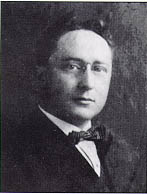
Chief of Construction Pffice of Public Roads |
| 1992 | With the south Florida coast beginning to recover from yesterday's devastating Hurricane Andrew, FHWA is on the scene assisting in damage assessment. In response to a request from Secretary of Transportation Andrew Card, Jr., for 100 USDOT volunteers to aid disaster relief workers, over 130 FHWA employees volunteer. (In North Carolina, Anna Beth Evans of FHWA's Raleigh Office of Motor Carriers, works with her State counterpart in a community effort to raise donated and purchased goods. Goods totalling 32,000 pounds, valued at $30,000, were transported to the disaster area in donated equipment.)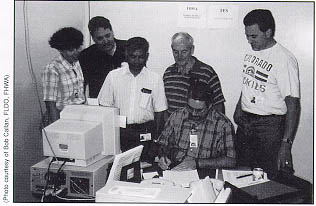
|
August 26
| 1977 | A 6-year U.S.-Saudi Arabian Highway Development Technical Assistance Agreement is signed in USDOT headquarters. Deputy Administrator Karl Bowers signs for FHWA. The Kingdom of Saudi Arabia, which is planning a $5-billion, 5-year highway program, agrees to reimburse FHWA for technical advisory services in the fields of highway organization, planning, programming, design, construction, and maintenance. The agreement, estimated to cost $6.3 million, will be carried out under the auspices of the Saudi Arabian-U.S. Joint Commission on Economic Cooperation.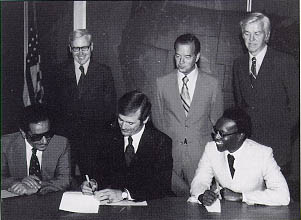
|
August 27
| 1958 | President Dwight D. Eisenhower signs Public Law 85-767, codifying all pertinent portions of existing Federal highway legislation as "Highways" (Title 23, United States Code), "Other Highways," and "General Provisions." Previously, the Federal laws on highways were contained in more than 40 separate enactments, beginning with the Federal Aid Road Act of 1916. Many overlapped, were contradictory, or were obsolete. In response to Section 12 of the Federal-Aid Highway Act of 1954, the Department of Commerce had recommended a draft consolidation law. |
| 1974 | Administrator Norbert Tiemann issues an FHWA Bulletin on "Studded Tire Policy" and writes to the Governors, advising them that, "Available information indicates that there is no net safety benefit to be derived from the use of present studded tires." He adds that in view of excessive wear and physical damage to roadway surfaces, State and local consideration of banning or limiting the use of studded tires is warranted. |
August 28
| 1958 | Tentative national standards for State regulation of outdoor advertising signs, displays, and devices adjacent to the Interstate System are published in the Federal Register in conformity with Section 12 of the Federal-Aid Highway Act of 1958. Some 275 pieces of correspondence will be reviewed before the final rules are issued on November 10, 1958. |
| 1965 | Senate Joint Resolution 81, Public Law 89-139, approved today, calls for biennial reporting of highway needs beginning in 1968. President Lyndon Johnson directs that, "It will not be enough merely to estimate how many miles of additional highway can or should be built or how much Federal money will be required to provide this mileage. Most important is a full and fair appraisal of the urban transportation problem and of the relative capability of various Federal programs, such as the highway program and the urban mass transit assistance program to meet various urban transportation requirements." Secretary of Transportation Alan Boyd submits the first report on January 31, 1968. It provides information on current highway transportation deficiencies and those that can be foreseen in the next 2 decades, particularly in urban areas. The report also indicates that future Federal-aid highway policy would require studies to redefine the Federal-aid systems, greater stress on urban transportation, added emphasis on coordination with other modes of transport, and continued emphasis on environmental enhancement through highway programs. |
August 29
| 1939 | Construction of the 105-mile Skyline Drive in the Shenandoah National Park is completed. Bids on the first Skyline Drive contract (19.97 miles from Thornton's Gap to Big Meadows, VA) had been opened on June 25, 1931. Albert Brothers Contractors, Inc., of Salem, VA, was awarded the contract on June 26. Work on the first section began on July 22 and was completed on schedule on September 8, 1932. By the time of its 50th anniversary in 1989, Skyline Drive had attracted more than 90 million visitors. As part of Shenandoah National Park, the drive serves a dual purpose. During the 50th anniversary, Chuck Anibel of the NPS explained, "It is a recreational experience in and of itself for the views and overlooks, as well as serving as an access road to the rest of the recreational facilities in the national park."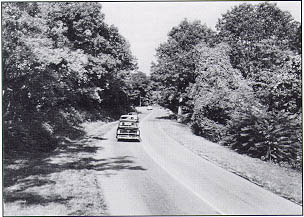
|
August 30
| 1967 | Without ceremony, workers remove barricades blocking the final section of the Adirondack Northway (I-87) in New York, the first long-distance, toll-free Interstate highway completed in the State. Construction of the $208-million, 176-mile highway began in 1957. On Mach 5, 1967, Parade Magazine had announced that the 23-mile section from Lake George to Pottersville was the Parade Scenic Highway for 1966 -- the new road that best embodies the principles of good design, beauty, and utility. Parade says, "At this time of year, those driving the Northway are enjoying snow-coated mountains or frozen reaches of Schroon Lake. In a few months . . . they will be seeing blossoms and mountain greenery. Whatever the season, few highways anywhere are more enjoyable to drive than Parade's Scenic Highway for 1966."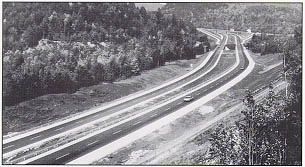
|
August 31
| 1907 | OPR issues Bulletin No. 32, Public Road Mileage, Revenues, and Expenditures in the United States in 1904.Compiled by Chief of Records M. O. Eldridge, the report is based on 60,000 letters sent out and reports received from every county in the U.S.--the first such compilation. The Nation has 2,151,570 miles of public roads outside cities, plus 1,598 miles of stone-surfaced toll roads. Only 153,662 miles had any kind of surfacing (defined as earth, gravel, stone, shells, and sand-clay). Total expenditures on roads in 1904 were $79.77 million; the States expended only $2.6 million of this amount.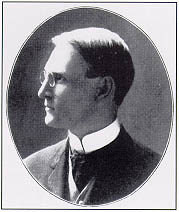
Assistant Director Office of Road Inquiries |
| 1924 | About 26 miles west of Missoula, MT, construction begins on a novel grade separation project designed by BPR. The completed structure carries the Yellowstone Trail under a railroad bridge and over 9-Mile Creek. The superstructure of the highway bridge is a reinforced concrete girder, 50-foot channel span with 36-foot approach spans on a skew of 40 degrees, which gives sufficient clearance from the foundations of the railroad bridge and maximum stream clearance. The bridge, which contains 306 cubic yards of concrete, costs $12,019. The project is completed in April 1925. |
| 1991 | Today, in Auburn, CA, BPR retirees meet for the 16th annual reunion of friends, associates, and families who met while working in BPR District 2 in San Francisco. Friendships begun 60-odd years ago, many while the engineers were in the field surveying or working on construction projects in National Forests and National Parks, had continued through the years of family building and moving around the country on BPR assignments. The first reunion, at the invitation of Mr. and Mrs. Linwood L. Clark, took place in August 1976 with a good attendance of old friends, although by then, according to Clark, some of the engineers could not attend because they were instead working for "St. Peter or Satan." He adds that, "Our group is getting smaller each year, but considering that most of us older retirees are in their 70s and 80s we think ourselves pretty fortunate." |
Also in August
| 1960 | Administrator Bertram Tallamy approves the addition of three Interstate routes in Hawaii under provisions of the Hawaii Omnibus Act. |
| 1963 | BPR issues the first Highway Planning Program Manual. |
| 1970 | Based on a report titled Benefits of Interstate Highways, Administrator Frank Turner announces that the Interstate System is "shrinking" distances between cities. "A 2,830-mile journey from New York to Los Angeles, which took 79 hours of travel in 1956 when Interstate mileage was negligible, can now be made in 62 hours by using Interstate routes in the same general corridor." He adds that the Interstate System is making educational, recreational, and cultural opportunities more accessible to the American people than ever before. |
| 1993 | EPA Administrator Carol Browner and Secretary of Transportation Federico Pea transmit a joint report to Congress titled Clean Air Through Transportation: Challenges in Meeting National Air Quality Standards. The report, required by Section 108(f)(3) of the Clean Air Act, as amended in 1990, discusses the challenges faced in attempting to improve air quality through transportation programs. The report concludes that, "While future success depends on our response to the challenges facing us, significant progress has been made [in] attainment of national ambient air quality standards."
"[The Clean Air Act] together with ISTEA calls for significant changes in the way we go about meeting transportation and air quality goals . . . ISTEA complements the Clean Air Act by giving State and local transportation officials the flexibility to use Federal transportation funds in ways that will help develop a balanced, environmentally sound, intermodal transportation system." |
